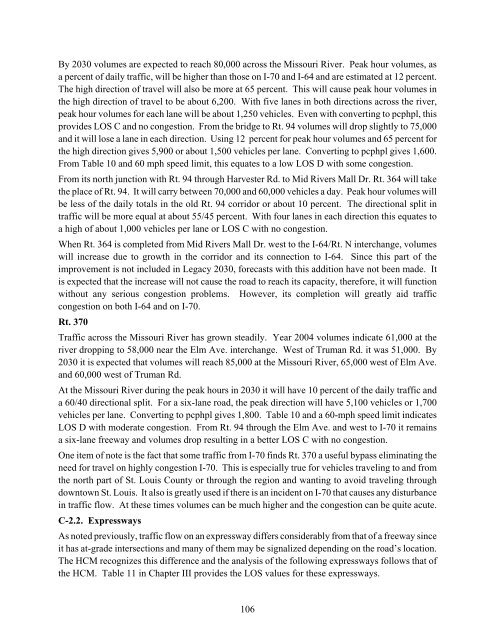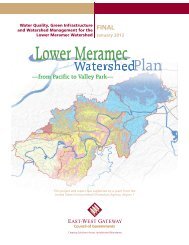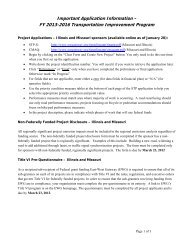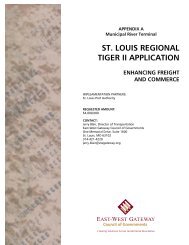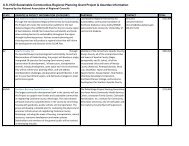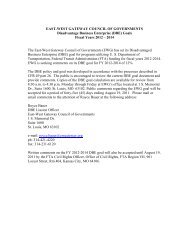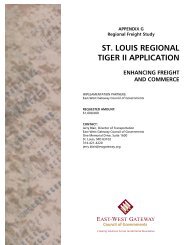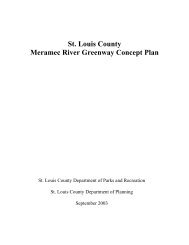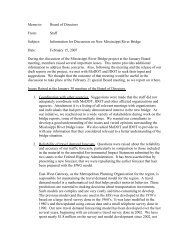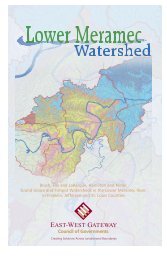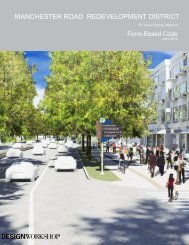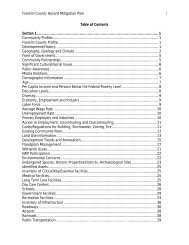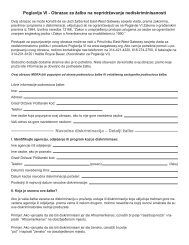St. Charles County Transportation Plan 2030 - East-West Gateway ...
St. Charles County Transportation Plan 2030 - East-West Gateway ...
St. Charles County Transportation Plan 2030 - East-West Gateway ...
Create successful ePaper yourself
Turn your PDF publications into a flip-book with our unique Google optimized e-Paper software.
By <strong>2030</strong> volumes are expected to reach 80,000 across the Missouri River. Peak hour volumes, as<br />
a percent of daily traffic, will be higher than those on I-70 and I-64 and are estimated at 12 percent.<br />
The high direction of travel will also be more at 65 percent. This will cause peak hour volumes in<br />
the high direction of travel to be about 6,200. With five lanes in both directions across the river,<br />
peak hour volumes for each lane will be about 1,250 vehicles. Even with converting to pcphpl, this<br />
provides LOS C and no congestion. From the bridge to Rt. 94 volumes will drop slightly to 75,000<br />
and it will lose a lane in each direction. Using 12 percent for peak hour volumes and 65 percent for<br />
the high direction gives 5,900 or about 1,500 vehicles per lane. Converting to pcphpl gives 1,600.<br />
From Table 10 and 60 mph speed limit, this equates to a low LOS D with some congestion.<br />
From its north junction with Rt. 94 through Harvester Rd. to Mid Rivers Mall Dr. Rt. 364 will take<br />
the place of Rt. 94. It will carry between 70,000 and 60,000 vehicles a day. Peak hour volumes will<br />
be less of the daily totals in the old Rt. 94 corridor or about 10 percent. The directional split in<br />
traffic will be more equal at about 55/45 percent. With four lanes in each direction this equates to<br />
a high of about 1,000 vehicles per lane or LOS C with no congestion.<br />
When Rt. 364 is completed from Mid Rivers Mall Dr. west to the I-64/Rt. N interchange, volumes<br />
will increase due to growth in the corridor and its connection to I-64. Since this part of the<br />
improvement is not included in Legacy <strong>2030</strong>, forecasts with this addition have not been made. It<br />
is expected that the increase will not cause the road to reach its capacity, therefore, it will function<br />
without any serious congestion problems. However, its completion will greatly aid traffic<br />
congestion on both I-64 and on I-70.<br />
Rt. 370<br />
Traffic across the Missouri River has grown steadily. Year 2004 volumes indicate 61,000 at the<br />
river dropping to 58,000 near the Elm Ave. interchange. <strong>West</strong> of Truman Rd. it was 51,000. By<br />
<strong>2030</strong> it is expected that volumes will reach 85,000 at the Missouri River, 65,000 west of Elm Ave.<br />
and 60,000 west of Truman Rd.<br />
At the Missouri River during the peak hours in <strong>2030</strong> it will have 10 percent of the daily traffic and<br />
a 60/40 directional split. For a six-lane road, the peak direction will have 5,100 vehicles or 1,700<br />
vehicles per lane. Converting to pcphpl gives 1,800. Table 10 and a 60-mph speed limit indicates<br />
LOS D with moderate congestion. From Rt. 94 through the Elm Ave. and west to I-70 it remains<br />
a six-lane freeway and volumes drop resulting in a better LOS C with no congestion.<br />
One item of note is the fact that some traffic from I-70 finds Rt. 370 a useful bypass eliminating the<br />
need for travel on highly congestion I-70. This is especially true for vehicles traveling to and from<br />
the north part of <strong>St</strong>. Louis <strong>County</strong> or through the region and wanting to avoid traveling through<br />
downtown <strong>St</strong>. Louis. It also is greatly used if there is an incident on I-70 that causes any disturbance<br />
in traffic flow. At these times volumes can be much higher and the congestion can be quite acute.<br />
C-2.2. Expressways<br />
As noted previously, traffic flow on an expressway differs considerably from that of a freeway since<br />
it has at-grade intersections and many of them may be signalized depending on the road’s location.<br />
The HCM recognizes this difference and the analysis of the following expressways follows that of<br />
the HCM. Table 11 in Chapter III provides the LOS values for these expressways.<br />
106


